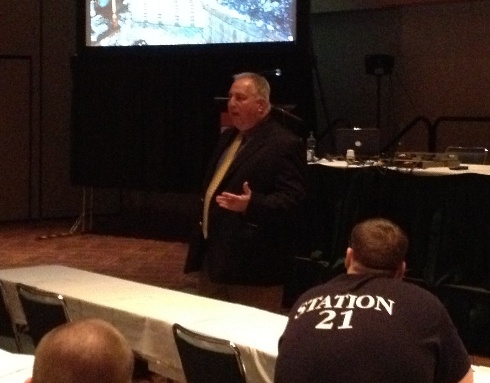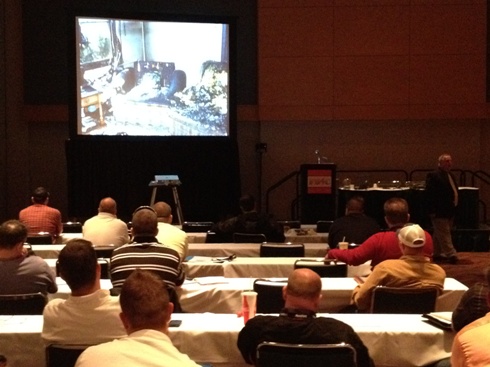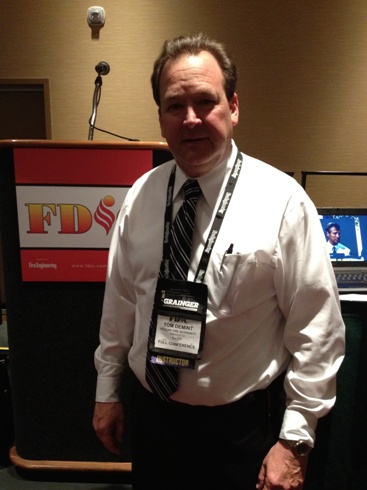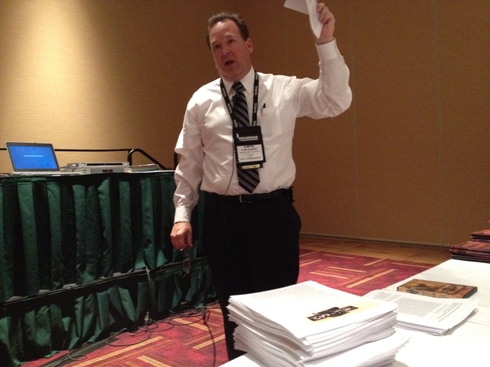At FDIC 2012 on Monday, April 16, afternoon class instructors Adrian “Buddy” Cales and Tom DeMint headed up two eye-opening courses that deal with two very different yet important subjects related to postfire outcomes and consequences.
ESSENTIALS OF FIRE INVESTIGATION
In Wabash Room 1, PSE&G Operations Systems Manager Cales led this detail-oriented discussion on the steps fire marshals and investigators must take when creating their initial reports.
Cales explained how all investigators should establish their own system to follow at each and every fire, and how they should never deviate from that pattern. “The system that they develop, they must follow at each scene they arrive at,” said Cales.
Cales covered all the information a good marshal/investigator needs to document when looking to paint an accurate portrait of an incident such as the following basic and preliminary information:
- When and how was the investigator notified of the fire, and by whom?
- The time and date first contacted. (Cales suggests always using AM/PM instead of military time when documenting the time.)
- Who notified the investigator; include his title and agency.
- Complete location details.
- Weather conditions.
- Who was the fire officer in charge of the scene (name, title, agency).
- Description of the building, vehicle, or area where the fire occurred.
Cales suggested the use of forms and checklists to document this and other vital information, and to never go into a scene assuming you know the origin of the fire. “You can’t rely, as one of your primary driving forces, that ‘this fire was set,’” he proclaimed.

“The manifestation that they will be held to is the report that will be submitted in court or in a civil proceeding. In other words, what makes them right, what makes their determination accurate,” he said.
“No fire is routine.”

Ultimately, Cales hoped to provide students with an understanding that each fire they investigate must be taken seriously.
“The object of this class is to provide everyone not with the direct process but with the method to their madness. They have to know what they need to do, they have to know the steps needed in advance, they have to be comfortable with and regurgitate stats at all fires big and small,” he concluded. “Many times, the report outlives the writer.”
TO HELL AND BACK: TRAIN THE TRAINER
In Room 136/137, Poudre (CO) Interim Chief Tom DeMint led a frank and sobering discussion on the subject of firefighter burn victims and how it affects both the victim and his colleagues in the wake of such horrible circumstances. The subjects were the focus of how all departments need to be properly trained to incorporate national standards of best practices to avoid the scenarios presented here.
The free To Hell and Back (THB) firefighter safety programs were developed with the help of Department of Homeland Security grants and are used by departments around the country to make sure that such events the program warns against are completely avoided.
To Hell and Back has three essential programs that students will be able to take home to their departments.
To Hell and Back I—This program contains the root program of four men who were critically injured in a fire along an Indianapolis freeway and their one year path to recovery. It demonstrates not only the physical strife but the emotional aspect of burn injuries as well. Integrated into the program is a classroom session that gives particular and measurable lesson plans for training. The tests and lesson plans are part of the curriculum and handouts of this session. Included in the THB I program is an EMS training session (not covered in the FDIC session) that can be used for training as well.
To Hell and Back II—This program is based on interviews with firefighters and/or their supervisors that were intimately involved in fires that caused firefighter injury or death. A lesson plan and testing materials are provided. The instructor provides more detailed and in depth reports from many of these firefighters. The personal stories of these firefighters help bring the message of firefighter safety to reality.
To Hell and Back IV—Cyanide – The fourth element of THB is the introduction to cyanide in smoke. Working with the Cyanide Poisoning Treatment Coalition, the THB development team created another video complete with lesson plans and testing materials free of charge to users.

Among the accounts DeMint presented to the class was the February 1992 Indianapolis Athletic Club fire which killed two firefighters and severely burned Indianapolis Fire Department Captain Mike Spaulding, who is featured prominently in the video series.
“This class demonstrates to students how to take this video and make it applicable to firefighters in their own departments. It will provide all the tools necessary to take the class back to home departments free of charge. It is a great program for new recruits as they enter into their firefighter-safety training,” said DeMint.

“The timeless program is also beneficial for incumbent firefighters, company officers, and chief officers to reinforce the critical necessity of proper protective gear, proper training as well as situational awareness, he concluded. “The class will also demonstrate how to take personal and local experiences and tie them into the program.”

